REEN 2215: Near Zero Energy Buildings and Renewable Energy Options
VerifiedAdded on 2023/01/18
|27
|6787
|63
Report
AI Summary
This report examines renewable energy technologies applicable to commercial buildings in rural settings, focusing on achieving Near Zero Energy Building (NZEB) standards as mandated by the European Union. The introduction highlights the significance of reducing carbon emissions within the construction industry and the role of renewable energy in meeting climate change goals. The report provides an overview of the NZEB directive, emphasizing the requirement for new buildings to be nearly zero-energy by 2020 and the incorporation of renewable energy sources. It then explores various renewable energy technologies suitable for building integration, including flat plate thermosiphon units, solar collectors with colored absorbers and booster reflectors, hydro photovoltaic, and Fresnel lenses, and building integrated solar/wind systems. A case study of a data center is included to demonstrate the application of these technologies. The report discusses the functional architecture and components of a renewable energy system, including power and RES management, thermal management, supervision, integration framework, and support tools. The report concludes by emphasizing the benefits of renewable energy technologies, such as energy supply security, sustainability, and enhanced employment opportunities, and their contribution to reducing reliance on fossil fuels and greenhouse gas emissions.
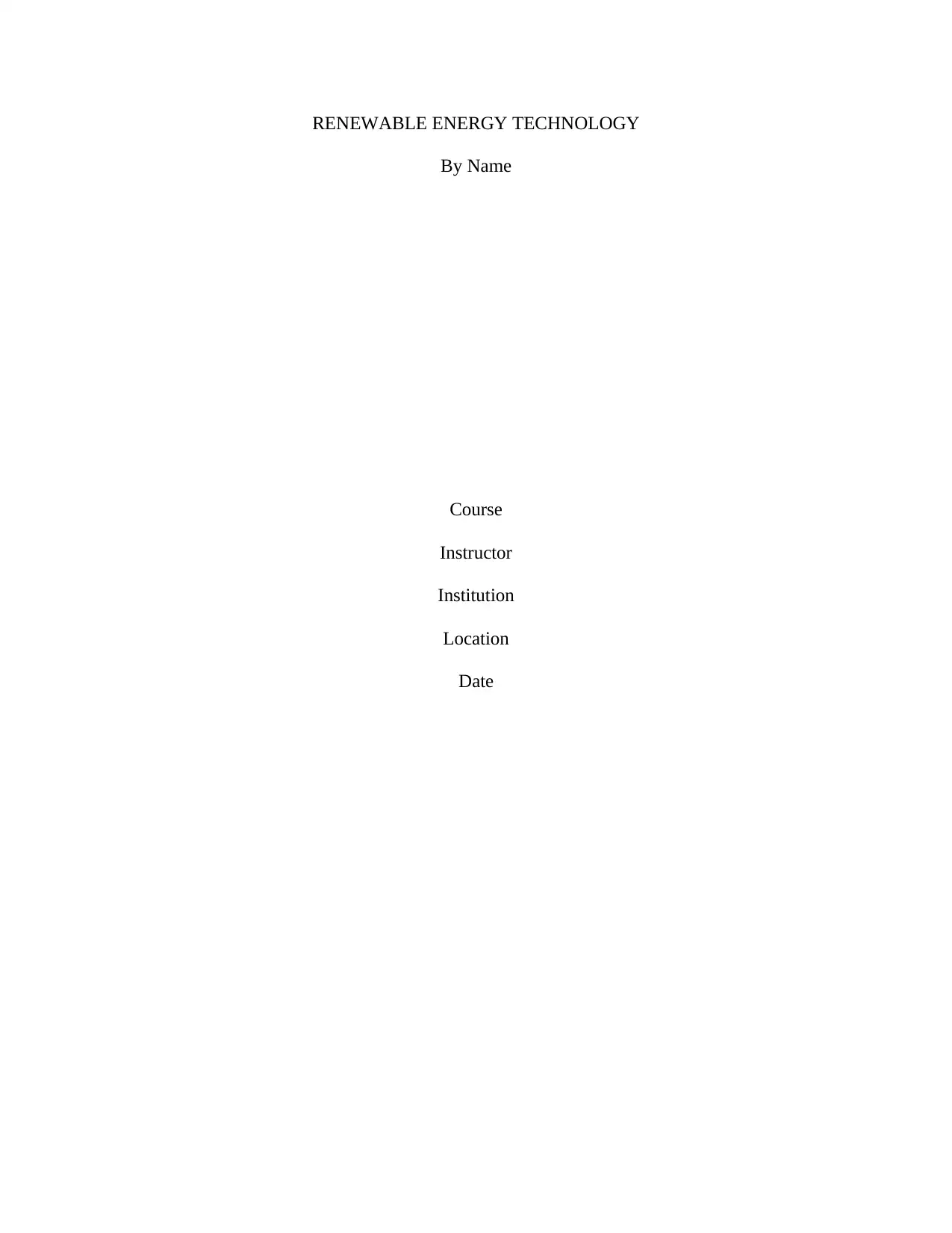
RENEWABLE ENERGY TECHNOLOGY
By Name
Course
Instructor
Institution
Location
Date
By Name
Course
Instructor
Institution
Location
Date
Paraphrase This Document
Need a fresh take? Get an instant paraphrase of this document with our AI Paraphraser

Contents
List of Acronyms..........................................................................................................................................3
RES-Renewable Energy Systems..................................................................................................................3
SEAI-Sustainable Energy Authority of Ireland..............................................................................................3
NEARLY ZERO ENERGY BUILDING STANDARD..............................................................................................4
Introduction.............................................................................................................................................4
Renewable Energy Technologies in Commercial Buildings in the Rural Setting...........................................6
Technologies for building integrated renewable energy..........................................................................7
Flat Plate Thermo siphon Units alongside Integrated Collector Storage..............................................9
Solar Collectors having Colored Absorbers.......................................................................................10
Solar Collectors having Booster Reflectors.......................................................................................10
Unglazed Solar Collectors.................................................................................................................11
Hydro photovoltaic............................................................................................................................11
Fresnel Lenses...................................................................................................................................11
Building Integration of Solar/Wind Systems.....................................................................................12
Smart air handling unit......................................................................................................................14
Case study of an existing data center........................................................................................................15
Functional architecture..........................................................................................................................16
Description of components in more details............................................................................................19
Power and RES Management GCG...................................................................................................19
Thermal Management GCG...............................................................................................................20
Supervision GCG...............................................................................................................................20
Integration Framework GCG.............................................................................................................21
Support Tool GCG.............................................................................................................................22
References.................................................................................................................................................24
List of Acronyms..........................................................................................................................................3
RES-Renewable Energy Systems..................................................................................................................3
SEAI-Sustainable Energy Authority of Ireland..............................................................................................3
NEARLY ZERO ENERGY BUILDING STANDARD..............................................................................................4
Introduction.............................................................................................................................................4
Renewable Energy Technologies in Commercial Buildings in the Rural Setting...........................................6
Technologies for building integrated renewable energy..........................................................................7
Flat Plate Thermo siphon Units alongside Integrated Collector Storage..............................................9
Solar Collectors having Colored Absorbers.......................................................................................10
Solar Collectors having Booster Reflectors.......................................................................................10
Unglazed Solar Collectors.................................................................................................................11
Hydro photovoltaic............................................................................................................................11
Fresnel Lenses...................................................................................................................................11
Building Integration of Solar/Wind Systems.....................................................................................12
Smart air handling unit......................................................................................................................14
Case study of an existing data center........................................................................................................15
Functional architecture..........................................................................................................................16
Description of components in more details............................................................................................19
Power and RES Management GCG...................................................................................................19
Thermal Management GCG...............................................................................................................20
Supervision GCG...............................................................................................................................20
Integration Framework GCG.............................................................................................................21
Support Tool GCG.............................................................................................................................22
References.................................................................................................................................................24
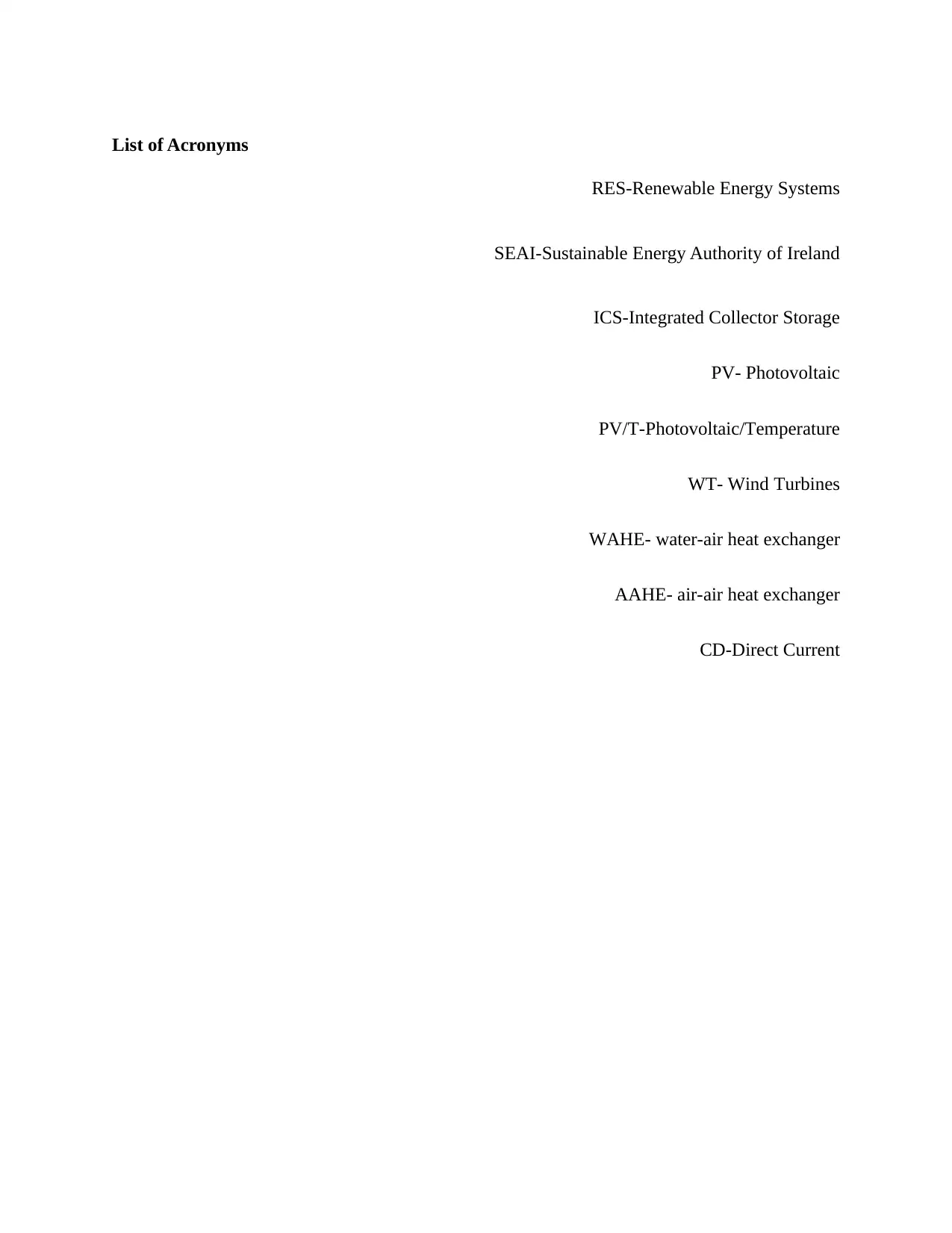
List of Acronyms
RES-Renewable Energy Systems
SEAI-Sustainable Energy Authority of Ireland
ICS-Integrated Collector Storage
PV- Photovoltaic
PV/T-Photovoltaic/Temperature
WT- Wind Turbines
WAHE- water-air heat exchanger
AAHE- air-air heat exchanger
CD-Direct Current
RES-Renewable Energy Systems
SEAI-Sustainable Energy Authority of Ireland
ICS-Integrated Collector Storage
PV- Photovoltaic
PV/T-Photovoltaic/Temperature
WT- Wind Turbines
WAHE- water-air heat exchanger
AAHE- air-air heat exchanger
CD-Direct Current
⊘ This is a preview!⊘
Do you want full access?
Subscribe today to unlock all pages.

Trusted by 1+ million students worldwide

NEARLY ZERO ENERGY BUILDING STANDARD
Introduction
The use of energy and emission of carbon dioxide linked with the construction industry as well
as the built environment continues to be important and strategies of reducing their effect on both
the existing alongside new buildings will remain an integral component of the policies of the
Government on energy and climate change. The most current data on carbon dioxide emissions
approximated that to the tune of 12.6 million tonnes of carbon dioxide was produced by the
sector of buildings in Ireland in 2010 which was a representative of 28.8% of the non-ETS
emissions (Annunziata, Frey and Rizzi, 2013).
Combustion of fossil fuels for purposes of heating in residential buildings represented about 7.8
tonnes or about 18% of the total emissions by 2010 with another 2.4 million tonnes otherwise
5% being derived from combustion of fossil fuel for the purposes of heating in the non-
residential buildings including schools, businesses, and hospitals. The industrial activities that
are under the European Union ETS represented a further 2.4 million tonnes which were about
6% of the total non-ETS emissions for the year 2010.
Against such a background, there have been advancements in the energy efficiency within the
sector of buildings in tandem with enhanced adoption of renewable energy technologies making
up significant policy measures required for the facilitation of a reduction in the energy
dependency of fossil fuels of Ireland as well as the accompanying greenhouse emissions of the
timeframe to 2020 and later.
Introduction
The use of energy and emission of carbon dioxide linked with the construction industry as well
as the built environment continues to be important and strategies of reducing their effect on both
the existing alongside new buildings will remain an integral component of the policies of the
Government on energy and climate change. The most current data on carbon dioxide emissions
approximated that to the tune of 12.6 million tonnes of carbon dioxide was produced by the
sector of buildings in Ireland in 2010 which was a representative of 28.8% of the non-ETS
emissions (Annunziata, Frey and Rizzi, 2013).
Combustion of fossil fuels for purposes of heating in residential buildings represented about 7.8
tonnes or about 18% of the total emissions by 2010 with another 2.4 million tonnes otherwise
5% being derived from combustion of fossil fuel for the purposes of heating in the non-
residential buildings including schools, businesses, and hospitals. The industrial activities that
are under the European Union ETS represented a further 2.4 million tonnes which were about
6% of the total non-ETS emissions for the year 2010.
Against such a background, there have been advancements in the energy efficiency within the
sector of buildings in tandem with enhanced adoption of renewable energy technologies making
up significant policy measures required for the facilitation of a reduction in the energy
dependency of fossil fuels of Ireland as well as the accompanying greenhouse emissions of the
timeframe to 2020 and later.
Paraphrase This Document
Need a fresh take? Get an instant paraphrase of this document with our AI Paraphraser
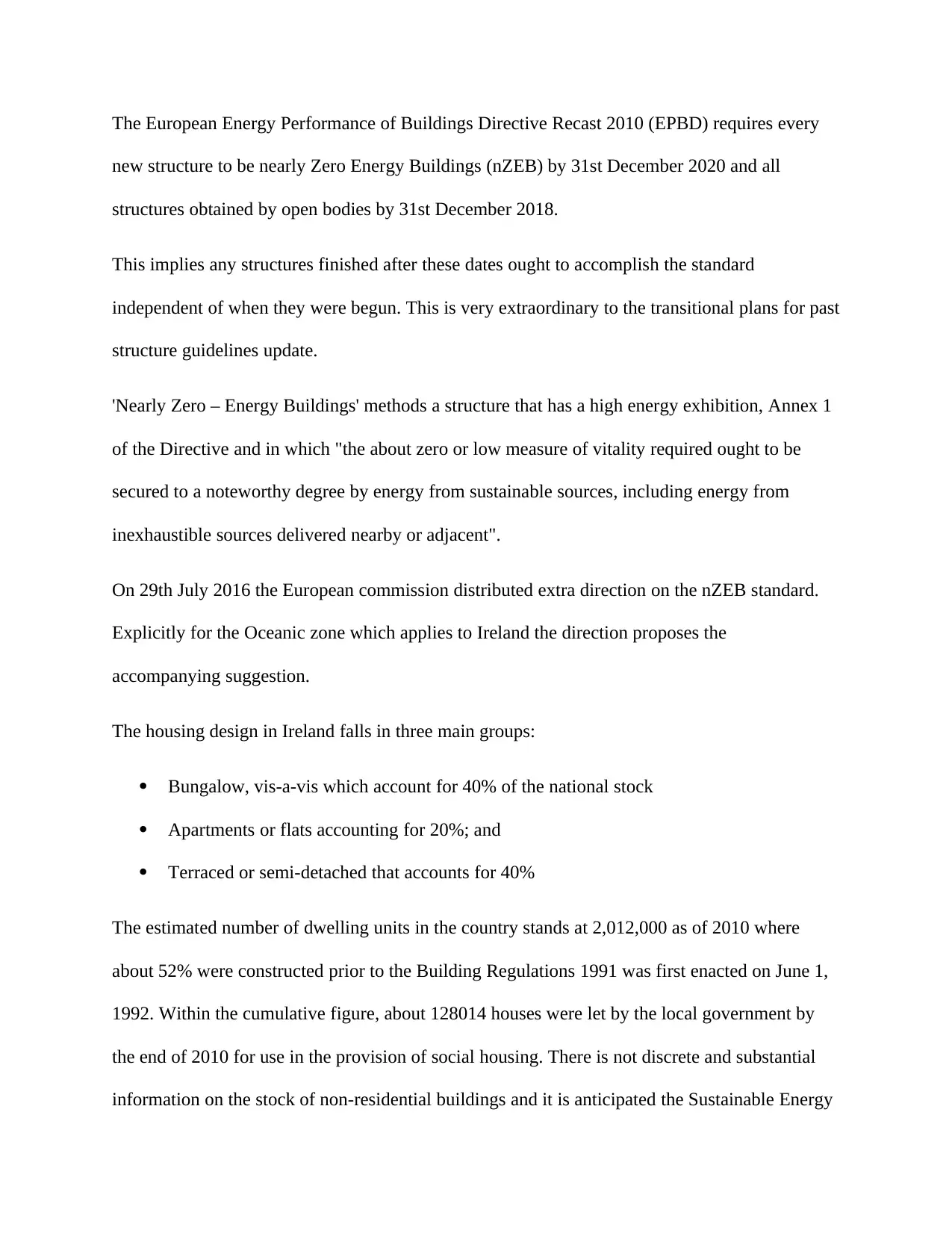
The European Energy Performance of Buildings Directive Recast 2010 (EPBD) requires every
new structure to be nearly Zero Energy Buildings (nZEB) by 31st December 2020 and all
structures obtained by open bodies by 31st December 2018.
This implies any structures finished after these dates ought to accomplish the standard
independent of when they were begun. This is very extraordinary to the transitional plans for past
structure guidelines update.
'Nearly Zero – Energy Buildings' methods a structure that has a high energy exhibition, Annex 1
of the Directive and in which "the about zero or low measure of vitality required ought to be
secured to a noteworthy degree by energy from sustainable sources, including energy from
inexhaustible sources delivered nearby or adjacent".
On 29th July 2016 the European commission distributed extra direction on the nZEB standard.
Explicitly for the Oceanic zone which applies to Ireland the direction proposes the
accompanying suggestion.
The housing design in Ireland falls in three main groups:
Bungalow, vis-a-vis which account for 40% of the national stock
Apartments or flats accounting for 20%; and
Terraced or semi-detached that accounts for 40%
The estimated number of dwelling units in the country stands at 2,012,000 as of 2010 where
about 52% were constructed prior to the Building Regulations 1991 was first enacted on June 1,
1992. Within the cumulative figure, about 128014 houses were let by the local government by
the end of 2010 for use in the provision of social housing. There is not discrete and substantial
information on the stock of non-residential buildings and it is anticipated the Sustainable Energy
new structure to be nearly Zero Energy Buildings (nZEB) by 31st December 2020 and all
structures obtained by open bodies by 31st December 2018.
This implies any structures finished after these dates ought to accomplish the standard
independent of when they were begun. This is very extraordinary to the transitional plans for past
structure guidelines update.
'Nearly Zero – Energy Buildings' methods a structure that has a high energy exhibition, Annex 1
of the Directive and in which "the about zero or low measure of vitality required ought to be
secured to a noteworthy degree by energy from sustainable sources, including energy from
inexhaustible sources delivered nearby or adjacent".
On 29th July 2016 the European commission distributed extra direction on the nZEB standard.
Explicitly for the Oceanic zone which applies to Ireland the direction proposes the
accompanying suggestion.
The housing design in Ireland falls in three main groups:
Bungalow, vis-a-vis which account for 40% of the national stock
Apartments or flats accounting for 20%; and
Terraced or semi-detached that accounts for 40%
The estimated number of dwelling units in the country stands at 2,012,000 as of 2010 where
about 52% were constructed prior to the Building Regulations 1991 was first enacted on June 1,
1992. Within the cumulative figure, about 128014 houses were let by the local government by
the end of 2010 for use in the provision of social housing. There is not discrete and substantial
information on the stock of non-residential buildings and it is anticipated the Sustainable Energy
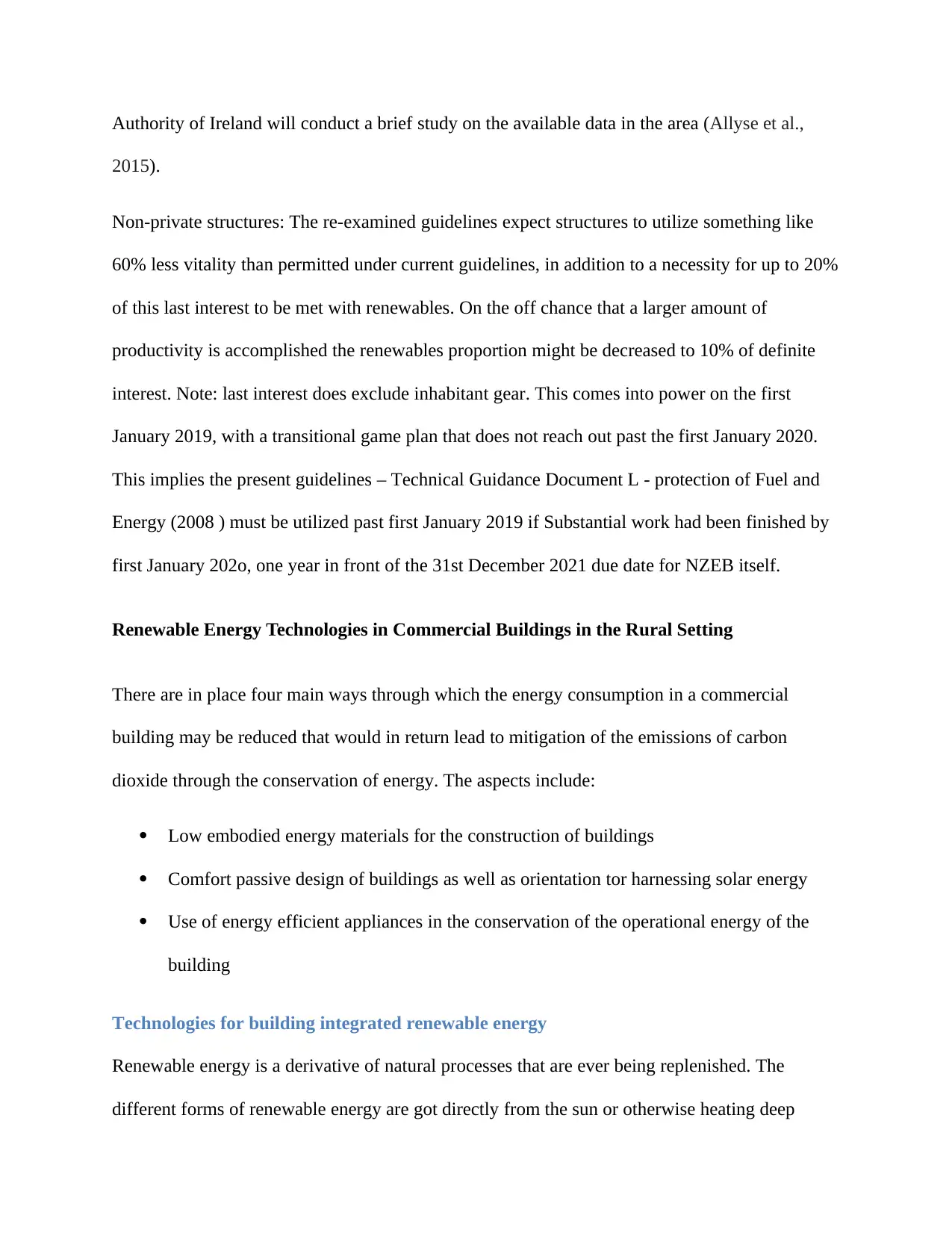
Authority of Ireland will conduct a brief study on the available data in the area (Allyse et al.,
2015).
Non-private structures: The re-examined guidelines expect structures to utilize something like
60% less vitality than permitted under current guidelines, in addition to a necessity for up to 20%
of this last interest to be met with renewables. On the off chance that a larger amount of
productivity is accomplished the renewables proportion might be decreased to 10% of definite
interest. Note: last interest does exclude inhabitant gear. This comes into power on the first
January 2019, with a transitional game plan that does not reach out past the first January 2020.
This implies the present guidelines – Technical Guidance Document L - protection of Fuel and
Energy (2008 ) must be utilized past first January 2019 if Substantial work had been finished by
first January 202o, one year in front of the 31st December 2021 due date for NZEB itself.
Renewable Energy Technologies in Commercial Buildings in the Rural Setting
There are in place four main ways through which the energy consumption in a commercial
building may be reduced that would in return lead to mitigation of the emissions of carbon
dioxide through the conservation of energy. The aspects include:
Low embodied energy materials for the construction of buildings
Comfort passive design of buildings as well as orientation tor harnessing solar energy
Use of energy efficient appliances in the conservation of the operational energy of the
building
Technologies for building integrated renewable energy
Renewable energy is a derivative of natural processes that are ever being replenished. The
different forms of renewable energy are got directly from the sun or otherwise heating deep
2015).
Non-private structures: The re-examined guidelines expect structures to utilize something like
60% less vitality than permitted under current guidelines, in addition to a necessity for up to 20%
of this last interest to be met with renewables. On the off chance that a larger amount of
productivity is accomplished the renewables proportion might be decreased to 10% of definite
interest. Note: last interest does exclude inhabitant gear. This comes into power on the first
January 2019, with a transitional game plan that does not reach out past the first January 2020.
This implies the present guidelines – Technical Guidance Document L - protection of Fuel and
Energy (2008 ) must be utilized past first January 2019 if Substantial work had been finished by
first January 202o, one year in front of the 31st December 2021 due date for NZEB itself.
Renewable Energy Technologies in Commercial Buildings in the Rural Setting
There are in place four main ways through which the energy consumption in a commercial
building may be reduced that would in return lead to mitigation of the emissions of carbon
dioxide through the conservation of energy. The aspects include:
Low embodied energy materials for the construction of buildings
Comfort passive design of buildings as well as orientation tor harnessing solar energy
Use of energy efficient appliances in the conservation of the operational energy of the
building
Technologies for building integrated renewable energy
Renewable energy is a derivative of natural processes that are ever being replenished. The
different forms of renewable energy are got directly from the sun or otherwise heating deep
⊘ This is a preview!⊘
Do you want full access?
Subscribe today to unlock all pages.

Trusted by 1+ million students worldwide

within the surface of the earth. The electricity, as well as the heat produced from the solar, wind,
ocean, biomass, hydropower, biofuel and geothermal sources along with hydrogen, got from
renewable sources areas as well considered as part of this definition (Goggins et al., 2016).
Among the technologies for renewable energy include:
Wind power
Biofuels
Micro-hydro
Biomass
Hydroelectricity
Going by the world status report that was generated in 2007, to the tune of 18% of the global
final energy that was consumed in 2006 was derived from renewables and another 13% being
generated from conventional biomass including the burning of wood. The next largest source that
was renewable was hydropower that provided 3% followed closely by hot water at 1.3%.
Modern technologies including solar, wind as well as ocean energy in total provided 0.8% of the
final consumed energy (Ahern, Griffiths and O'Flaherty, 2013). Hence, the technical ability for
the use of such technologies is large that goes beyond all the other sources that are readily
available.
A substantial amount of electricity, as well as heat needs of a structure, may be covered
effectively through the use of photovoltaic and solar thermal collectors. In the times to come,
other sources of renewable energy would be applied including wind turbines, hydrogen, and
biomass in the minimization of use of conventional sources of energy. Nuclear energy as well as
wind turbines, hydrogen and biomass may be taken into consideration optional sources of energy
to evade the greenhouse effect. In between such two sources of energy, only wind turbines,
ocean, biomass, hydropower, biofuel and geothermal sources along with hydrogen, got from
renewable sources areas as well considered as part of this definition (Goggins et al., 2016).
Among the technologies for renewable energy include:
Wind power
Biofuels
Micro-hydro
Biomass
Hydroelectricity
Going by the world status report that was generated in 2007, to the tune of 18% of the global
final energy that was consumed in 2006 was derived from renewables and another 13% being
generated from conventional biomass including the burning of wood. The next largest source that
was renewable was hydropower that provided 3% followed closely by hot water at 1.3%.
Modern technologies including solar, wind as well as ocean energy in total provided 0.8% of the
final consumed energy (Ahern, Griffiths and O'Flaherty, 2013). Hence, the technical ability for
the use of such technologies is large that goes beyond all the other sources that are readily
available.
A substantial amount of electricity, as well as heat needs of a structure, may be covered
effectively through the use of photovoltaic and solar thermal collectors. In the times to come,
other sources of renewable energy would be applied including wind turbines, hydrogen, and
biomass in the minimization of use of conventional sources of energy. Nuclear energy as well as
wind turbines, hydrogen and biomass may be taken into consideration optional sources of energy
to evade the greenhouse effect. In between such two sources of energy, only wind turbines,
Paraphrase This Document
Need a fresh take? Get an instant paraphrase of this document with our AI Paraphraser
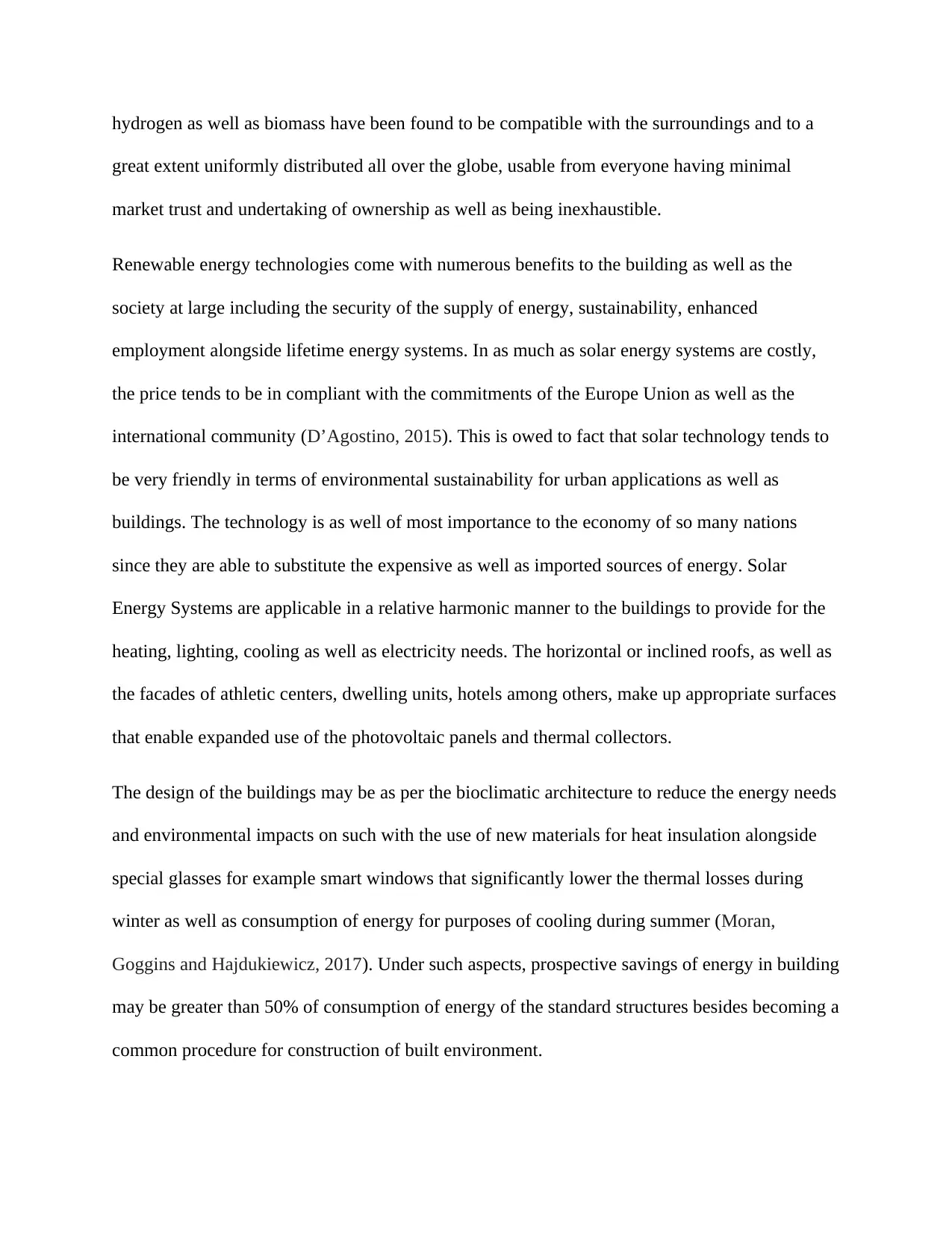
hydrogen as well as biomass have been found to be compatible with the surroundings and to a
great extent uniformly distributed all over the globe, usable from everyone having minimal
market trust and undertaking of ownership as well as being inexhaustible.
Renewable energy technologies come with numerous benefits to the building as well as the
society at large including the security of the supply of energy, sustainability, enhanced
employment alongside lifetime energy systems. In as much as solar energy systems are costly,
the price tends to be in compliant with the commitments of the Europe Union as well as the
international community (D’Agostino, 2015). This is owed to fact that solar technology tends to
be very friendly in terms of environmental sustainability for urban applications as well as
buildings. The technology is as well of most importance to the economy of so many nations
since they are able to substitute the expensive as well as imported sources of energy. Solar
Energy Systems are applicable in a relative harmonic manner to the buildings to provide for the
heating, lighting, cooling as well as electricity needs. The horizontal or inclined roofs, as well as
the facades of athletic centers, dwelling units, hotels among others, make up appropriate surfaces
that enable expanded use of the photovoltaic panels and thermal collectors.
The design of the buildings may be as per the bioclimatic architecture to reduce the energy needs
and environmental impacts on such with the use of new materials for heat insulation alongside
special glasses for example smart windows that significantly lower the thermal losses during
winter as well as consumption of energy for purposes of cooling during summer (Moran,
Goggins and Hajdukiewicz, 2017). Under such aspects, prospective savings of energy in building
may be greater than 50% of consumption of energy of the standard structures besides becoming a
common procedure for construction of built environment.
great extent uniformly distributed all over the globe, usable from everyone having minimal
market trust and undertaking of ownership as well as being inexhaustible.
Renewable energy technologies come with numerous benefits to the building as well as the
society at large including the security of the supply of energy, sustainability, enhanced
employment alongside lifetime energy systems. In as much as solar energy systems are costly,
the price tends to be in compliant with the commitments of the Europe Union as well as the
international community (D’Agostino, 2015). This is owed to fact that solar technology tends to
be very friendly in terms of environmental sustainability for urban applications as well as
buildings. The technology is as well of most importance to the economy of so many nations
since they are able to substitute the expensive as well as imported sources of energy. Solar
Energy Systems are applicable in a relative harmonic manner to the buildings to provide for the
heating, lighting, cooling as well as electricity needs. The horizontal or inclined roofs, as well as
the facades of athletic centers, dwelling units, hotels among others, make up appropriate surfaces
that enable expanded use of the photovoltaic panels and thermal collectors.
The design of the buildings may be as per the bioclimatic architecture to reduce the energy needs
and environmental impacts on such with the use of new materials for heat insulation alongside
special glasses for example smart windows that significantly lower the thermal losses during
winter as well as consumption of energy for purposes of cooling during summer (Moran,
Goggins and Hajdukiewicz, 2017). Under such aspects, prospective savings of energy in building
may be greater than 50% of consumption of energy of the standard structures besides becoming a
common procedure for construction of built environment.
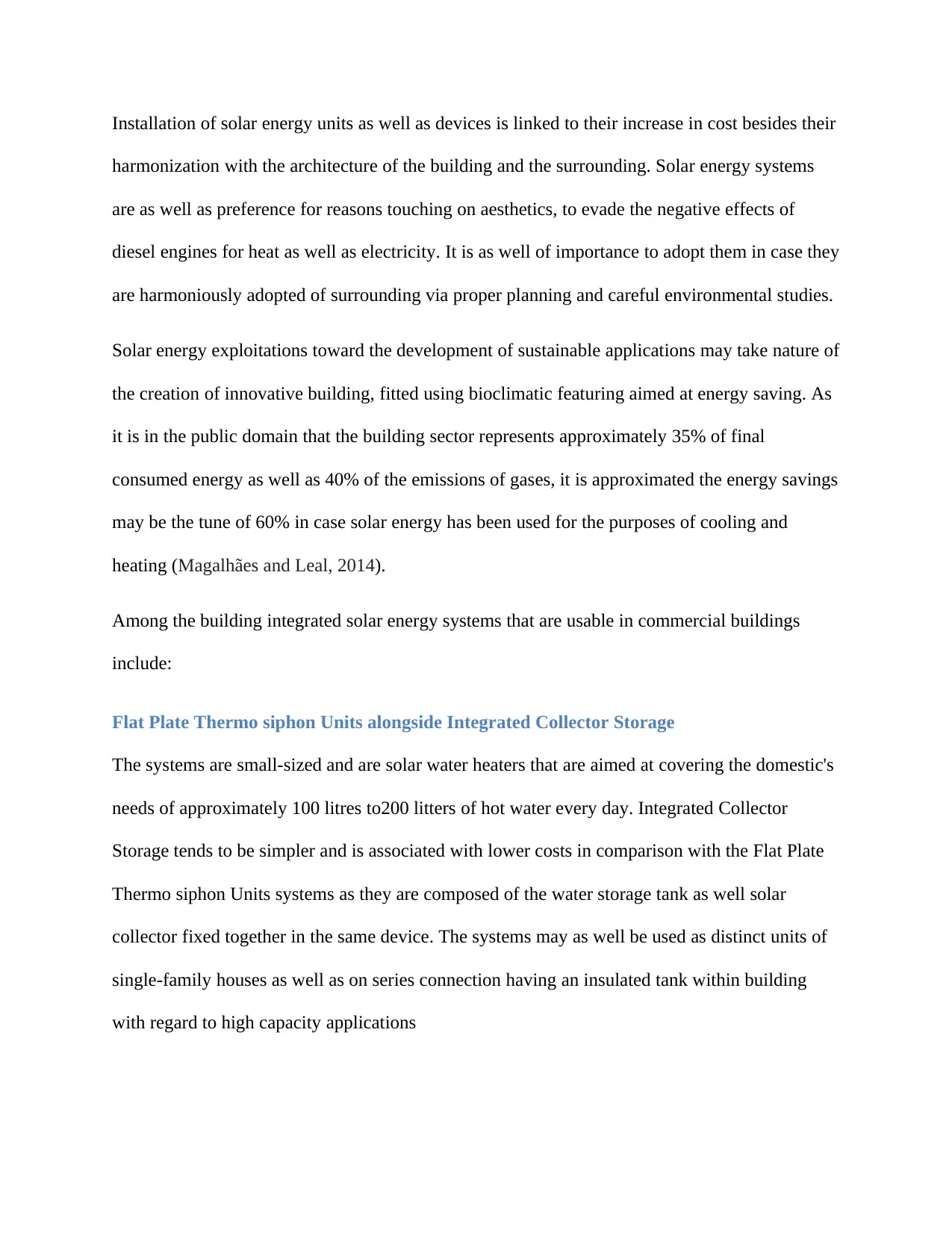
Installation of solar energy units as well as devices is linked to their increase in cost besides their
harmonization with the architecture of the building and the surrounding. Solar energy systems
are as well as preference for reasons touching on aesthetics, to evade the negative effects of
diesel engines for heat as well as electricity. It is as well of importance to adopt them in case they
are harmoniously adopted of surrounding via proper planning and careful environmental studies.
Solar energy exploitations toward the development of sustainable applications may take nature of
the creation of innovative building, fitted using bioclimatic featuring aimed at energy saving. As
it is in the public domain that the building sector represents approximately 35% of final
consumed energy as well as 40% of the emissions of gases, it is approximated the energy savings
may be the tune of 60% in case solar energy has been used for the purposes of cooling and
heating (Magalhães and Leal, 2014).
Among the building integrated solar energy systems that are usable in commercial buildings
include:
Flat Plate Thermo siphon Units alongside Integrated Collector Storage
The systems are small-sized and are solar water heaters that are aimed at covering the domestic's
needs of approximately 100 litres to200 litters of hot water every day. Integrated Collector
Storage tends to be simpler and is associated with lower costs in comparison with the Flat Plate
Thermo siphon Units systems as they are composed of the water storage tank as well solar
collector fixed together in the same device. The systems may as well be used as distinct units of
single-family houses as well as on series connection having an insulated tank within building
with regard to high capacity applications
harmonization with the architecture of the building and the surrounding. Solar energy systems
are as well as preference for reasons touching on aesthetics, to evade the negative effects of
diesel engines for heat as well as electricity. It is as well of importance to adopt them in case they
are harmoniously adopted of surrounding via proper planning and careful environmental studies.
Solar energy exploitations toward the development of sustainable applications may take nature of
the creation of innovative building, fitted using bioclimatic featuring aimed at energy saving. As
it is in the public domain that the building sector represents approximately 35% of final
consumed energy as well as 40% of the emissions of gases, it is approximated the energy savings
may be the tune of 60% in case solar energy has been used for the purposes of cooling and
heating (Magalhães and Leal, 2014).
Among the building integrated solar energy systems that are usable in commercial buildings
include:
Flat Plate Thermo siphon Units alongside Integrated Collector Storage
The systems are small-sized and are solar water heaters that are aimed at covering the domestic's
needs of approximately 100 litres to200 litters of hot water every day. Integrated Collector
Storage tends to be simpler and is associated with lower costs in comparison with the Flat Plate
Thermo siphon Units systems as they are composed of the water storage tank as well solar
collector fixed together in the same device. The systems may as well be used as distinct units of
single-family houses as well as on series connection having an insulated tank within building
with regard to high capacity applications
⊘ This is a preview!⊘
Do you want full access?
Subscribe today to unlock all pages.

Trusted by 1+ million students worldwide
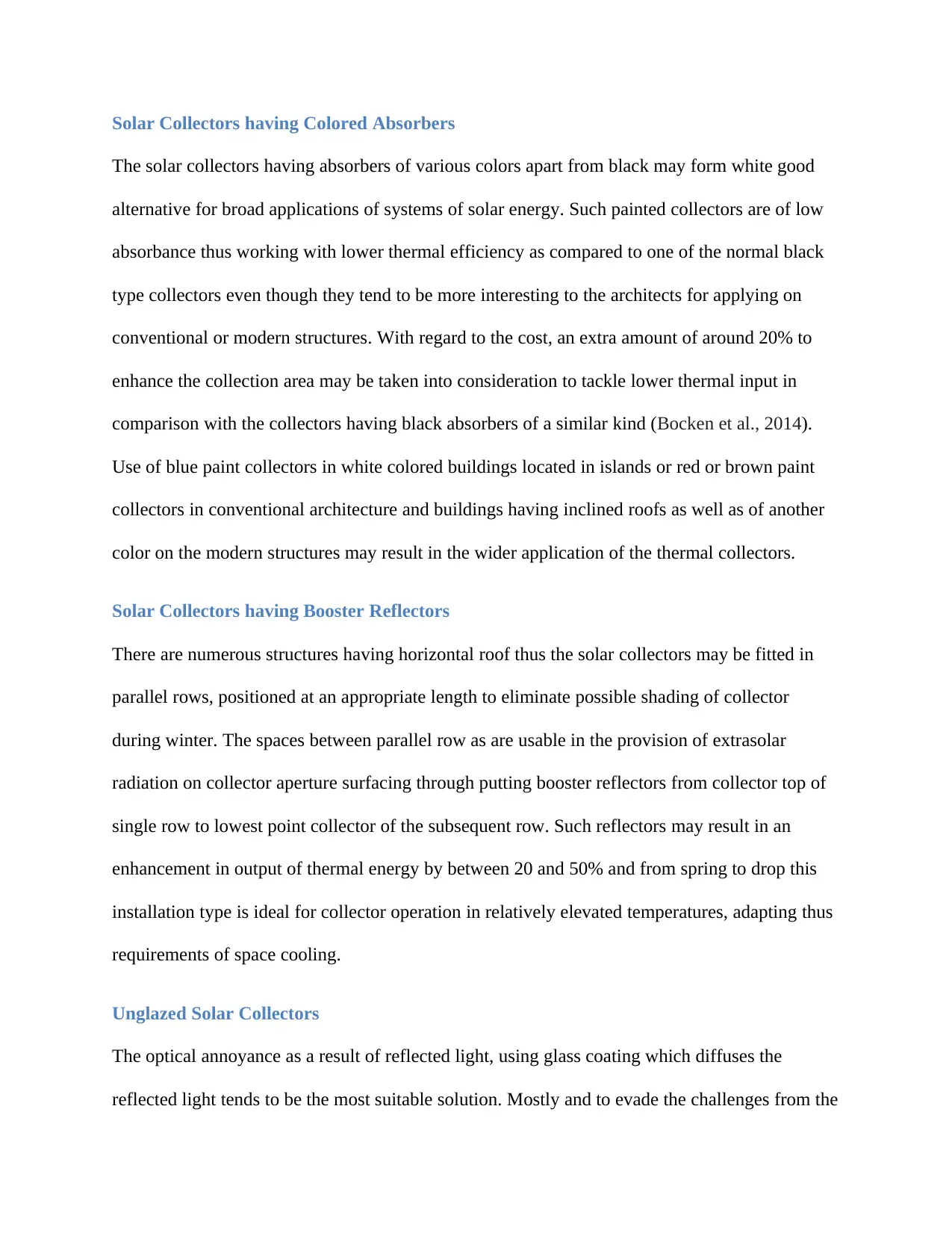
Solar Collectors having Colored Absorbers
The solar collectors having absorbers of various colors apart from black may form white good
alternative for broad applications of systems of solar energy. Such painted collectors are of low
absorbance thus working with lower thermal efficiency as compared to one of the normal black
type collectors even though they tend to be more interesting to the architects for applying on
conventional or modern structures. With regard to the cost, an extra amount of around 20% to
enhance the collection area may be taken into consideration to tackle lower thermal input in
comparison with the collectors having black absorbers of a similar kind (Bocken et al., 2014).
Use of blue paint collectors in white colored buildings located in islands or red or brown paint
collectors in conventional architecture and buildings having inclined roofs as well as of another
color on the modern structures may result in the wider application of the thermal collectors.
Solar Collectors having Booster Reflectors
There are numerous structures having horizontal roof thus the solar collectors may be fitted in
parallel rows, positioned at an appropriate length to eliminate possible shading of collector
during winter. The spaces between parallel row as are usable in the provision of extrasolar
radiation on collector aperture surfacing through putting booster reflectors from collector top of
single row to lowest point collector of the subsequent row. Such reflectors may result in an
enhancement in output of thermal energy by between 20 and 50% and from spring to drop this
installation type is ideal for collector operation in relatively elevated temperatures, adapting thus
requirements of space cooling.
Unglazed Solar Collectors
The optical annoyance as a result of reflected light, using glass coating which diffuses the
reflected light tends to be the most suitable solution. Mostly and to evade the challenges from the
The solar collectors having absorbers of various colors apart from black may form white good
alternative for broad applications of systems of solar energy. Such painted collectors are of low
absorbance thus working with lower thermal efficiency as compared to one of the normal black
type collectors even though they tend to be more interesting to the architects for applying on
conventional or modern structures. With regard to the cost, an extra amount of around 20% to
enhance the collection area may be taken into consideration to tackle lower thermal input in
comparison with the collectors having black absorbers of a similar kind (Bocken et al., 2014).
Use of blue paint collectors in white colored buildings located in islands or red or brown paint
collectors in conventional architecture and buildings having inclined roofs as well as of another
color on the modern structures may result in the wider application of the thermal collectors.
Solar Collectors having Booster Reflectors
There are numerous structures having horizontal roof thus the solar collectors may be fitted in
parallel rows, positioned at an appropriate length to eliminate possible shading of collector
during winter. The spaces between parallel row as are usable in the provision of extrasolar
radiation on collector aperture surfacing through putting booster reflectors from collector top of
single row to lowest point collector of the subsequent row. Such reflectors may result in an
enhancement in output of thermal energy by between 20 and 50% and from spring to drop this
installation type is ideal for collector operation in relatively elevated temperatures, adapting thus
requirements of space cooling.
Unglazed Solar Collectors
The optical annoyance as a result of reflected light, using glass coating which diffuses the
reflected light tends to be the most suitable solution. Mostly and to evade the challenges from the
Paraphrase This Document
Need a fresh take? Get an instant paraphrase of this document with our AI Paraphraser

glare, it is taken into consideration worth using unglazed solar collectors for applications of low
temperature (Boons, Montalvo, Quist and Wagner, 2013). The unglazed solar connectors may be
an alternative to a basic
Hydro photovoltaic
The solar-powered energy frameworks that give power and warmth all the while are the half
breed photovoltaic/temperature (PV/T) frameworks, that comprised of modules of PV coupled to
water or air heat extraction gadgets accomplishing a higher energy change proficiency of
retained sunlight based radiation. Such establishments may add to building regular ventilation,
working as sun based fireplaces on structure exterior as well as slanted rooftop.
The PV module gives power and furthermore stacks impact that may be used to warm room
during winter by the distribution of room air via vents. The equivalent PV-Trombe wall may cool
the space by giving fireplace impact to circle external air to divert warmth gain and in this
manner cooling room air via initiated ventilation in stack (Bridge, Bouzarovski, Bradshaw and
Eyre, 2013). The course of action may be changed into PV-Trombe wall by initiating progression
of cool air into room from the room shadow side and afterward going it via the fireplace that
likewise gives cooling impact in the room.
Fresnel Lenses
Fresnel focal points are optical gadgets for sunlight based radiation focus; of lower volume as
well as weight, littler central length alongside lower cost, contrasted with the thick conventional
focal points. The favorable position to isolate direct from diffuse sunlight based radiation renders
Fresnel focal points appropriate for brightening control of structure inside space, giving the light
of reasonable power level; without sharp differentiations. The Fresnel focal point idea has been
temperature (Boons, Montalvo, Quist and Wagner, 2013). The unglazed solar connectors may be
an alternative to a basic
Hydro photovoltaic
The solar-powered energy frameworks that give power and warmth all the while are the half
breed photovoltaic/temperature (PV/T) frameworks, that comprised of modules of PV coupled to
water or air heat extraction gadgets accomplishing a higher energy change proficiency of
retained sunlight based radiation. Such establishments may add to building regular ventilation,
working as sun based fireplaces on structure exterior as well as slanted rooftop.
The PV module gives power and furthermore stacks impact that may be used to warm room
during winter by the distribution of room air via vents. The equivalent PV-Trombe wall may cool
the space by giving fireplace impact to circle external air to divert warmth gain and in this
manner cooling room air via initiated ventilation in stack (Bridge, Bouzarovski, Bradshaw and
Eyre, 2013). The course of action may be changed into PV-Trombe wall by initiating progression
of cool air into room from the room shadow side and afterward going it via the fireplace that
likewise gives cooling impact in the room.
Fresnel Lenses
Fresnel focal points are optical gadgets for sunlight based radiation focus; of lower volume as
well as weight, littler central length alongside lower cost, contrasted with the thick conventional
focal points. The favorable position to isolate direct from diffuse sunlight based radiation renders
Fresnel focal points appropriate for brightening control of structure inside space, giving the light
of reasonable power level; without sharp differentiations. The Fresnel focal point idea has been

recommended for sun oriented control of structures to keep light and inside temperature at solace
level. Research center scale exploratory outcomes give a thought regarding the use of this new
optical framework (Zuo and Zhao, 2014). The accumulation of 60– 80% of transmitted sunlight
based radiation via Fresnel focal points on direct safeguards leaves rest to add up to be conveyed
in the inside space for light and warm structure needs. In low force sun based radiation,
safeguard may be out of center, leaving all light to come in inside space thereby keep brightening
at an adequate dimension. The Fresnel focal points may be joined with warm, photovoltaic, or
crossbreed kind of photovoltaic/warm safeguards to gather and concentrate packed solar-
powered radiation as warmth, power or even both.
Building Integration of Solar/Wind Systems
Yet another fascinating topic which has been contemplated is structure coordination of solar-
powered as well as wind energy frameworks. Both of these gadgets have all the earmarks of
being the most intriguing among sustainable power hotspots for the manufactured condition. The
veneers and the level or slanted tops of houses, lodgings, athletic focuses and structures of
different kinds are suitable surfaces for the utilization of sunlight based energy change
frameworks as they are the photovoltaic boards and the warm gatherers for the power and
warmth request separately (Cabeza et al., 2014).
Other than them, little wind turbines (WT) may be mounted on structure rooftops, fundamentally
at areas with attractive breeze speed potential. The utilization of little WT to average lattice
associated private structures, inns, and so on, is as of late recommended to give power supply
and are appropriate mostly for decentralized uses. Likewise, they may be viably joined in
correlative task with photovoltaic and sun based warm gatherers. Toward this path, there are
different frameworks grown, for example, wind turbines or even (HAWT) or vertical (VAWT)
level. Research center scale exploratory outcomes give a thought regarding the use of this new
optical framework (Zuo and Zhao, 2014). The accumulation of 60– 80% of transmitted sunlight
based radiation via Fresnel focal points on direct safeguards leaves rest to add up to be conveyed
in the inside space for light and warm structure needs. In low force sun based radiation,
safeguard may be out of center, leaving all light to come in inside space thereby keep brightening
at an adequate dimension. The Fresnel focal points may be joined with warm, photovoltaic, or
crossbreed kind of photovoltaic/warm safeguards to gather and concentrate packed solar-
powered radiation as warmth, power or even both.
Building Integration of Solar/Wind Systems
Yet another fascinating topic which has been contemplated is structure coordination of solar-
powered as well as wind energy frameworks. Both of these gadgets have all the earmarks of
being the most intriguing among sustainable power hotspots for the manufactured condition. The
veneers and the level or slanted tops of houses, lodgings, athletic focuses and structures of
different kinds are suitable surfaces for the utilization of sunlight based energy change
frameworks as they are the photovoltaic boards and the warm gatherers for the power and
warmth request separately (Cabeza et al., 2014).
Other than them, little wind turbines (WT) may be mounted on structure rooftops, fundamentally
at areas with attractive breeze speed potential. The utilization of little WT to average lattice
associated private structures, inns, and so on, is as of late recommended to give power supply
and are appropriate mostly for decentralized uses. Likewise, they may be viably joined in
correlative task with photovoltaic and sun based warm gatherers. Toward this path, there are
different frameworks grown, for example, wind turbines or even (HAWT) or vertical (VAWT)
⊘ This is a preview!⊘
Do you want full access?
Subscribe today to unlock all pages.

Trusted by 1+ million students worldwide
1 out of 27
Related Documents
Your All-in-One AI-Powered Toolkit for Academic Success.
+13062052269
info@desklib.com
Available 24*7 on WhatsApp / Email
![[object Object]](/_next/static/media/star-bottom.7253800d.svg)
Unlock your academic potential
Copyright © 2020–2025 A2Z Services. All Rights Reserved. Developed and managed by ZUCOL.




